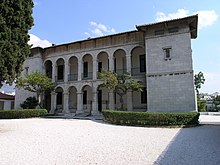Sophie de Marbois-Lebrun
Sophie de Marbois-Lebrun , duchesse de Plaisance (Duchess of Piacenza, Greek Σοφία Λεμπρέν, Δούκισσα της Πλακεντίας Doukissa tis Plakentias ; * April 2, 1785 in Philadelphia in the US state of Pennsylvania ; † May 14, 1854 was a French philosopher in Philadelphia in Athens ; † May 14, 1854 Origin.
Life
Sophie de Marbois-Lebrun was born in the United States as the daughter of the French Consul General François Barbé-Marbois and an American mother. In 1802 she married Colonel Anne Charles Lebrun (1775-1859) in Paris , later Duke of Piacenza ( French duc de Plaisance), a son of Charles-François Lebrun , who was one of the three consuls of Napoleon Bonaparte from 1799 to 1804 France was. She had a daughter with him, Caroline-Eliza (* 1804). The couple soon lived apart and eventually divorced in 1831. The Duke was Governor of Holland from 1811 to 1813; Sophie traveled to Italy several times with her daughter.
Support for the Greek cause and first stay in Greece
In Rome in 1825 she met Ioannis Kapodistrias , the representative of the Greek freedom fighters . This encounter had a lasting impact on her, from then on she supported the Greek cause generously financially, but also coordinated the activities of the French philhellenes.
In particular, she supported the establishment of state primary schools in Greece and took on the education of twelve daughters of freedom fighters.
At the end of 1829 she traveled with her daughter via Corfu and Patras to Nafplio , the then capital of Greece. She met Kapodistrias again, but soon got into disagreement with him and left Greece after 17 months for Italy. After Kapodistrias was murdered by members of the Mavromichalis family , she spoke out against the way in which Kapodistrias had ruled the country.
Move to Athens
The Duchess did not return to France after her divorce in 1831. She stayed in Florence for a while , returned to Greece in 1834 and settled in the new capital, Athens. She acquired large amounts of agricultural land around Athens, particularly near Mount Pendeli . She commissioned the architect Stamatios Kleanthis to design a palace on the slope of the Pendeli. In the meantime she traveled to Beirut with her daughter in 1836 , where Eliza died of a lung disease. She had the body embalmed and returned to Athens, where it was buried in a crypt under her house on Piraeus Street.
Kleanthis completed the Duchesse de Plaisance building on Pendeli in 1841 and then worked on the Villa Illisia near the Royal Palace, which he completed in 1848. Villa Illisia is now home to the Byzantine and Christian Museum .
As the center of social life in Athens, King Otto I , the Duchess held symposia on various religious and political topics in her palace. She did not convert to the Greek Orthodox Church , but to Judaism and supported the construction of a Jewish temple in Chalkida on Evia . It also financed the publication of the Messolongi Chronicle .
She was considered an eccentric personality, especially after the death of her daughter, about whom there were strange stories. She was even associated with the bandits who were up to mischief on the Pendeli; an alleged affair with the robber chief Christos Davelis may have been invented; in fact she is said to have been held captive by the bandit Bimbili and only released after paying a ransom.
She later commissioned Kleanthis to build Rododafni Castle on Pendeli; In addition to the castle-like palace, she had three other buildings ( maisonette , plaisance and tourelle ) and a bridge erected as the final resting place for the remains of her daughter. However, it did not live to see completion because the building burned down in 1847. After that, the Duchess withdrew from public life and only had contact with her friend Fotini Mavromichali, a chambermaid of Queen Amalia .
After her death in 1854, her nephew sold her lands to the Greek state. She was buried with her daughter in her tower on Pendeli.
A station of the Athens Metro , which is located on one of its previous properties, was named after it Doukissis Plakentias (Δουκίσσης Πλακεντίας).
literature
- Paul Elsner: The Duchess of Plaisance . In: Pictures from New Hellas. Aarau 1902, pp. 294-306.
- Richard Voss: The Duchess of Plaisance . Stuttgart 1912 (Engelhorn's general novel library).
- Florence Codman: Fitful rebel - Sophie de Marbois Duchesse de Plaisance . Paris 1965.
Web links
- Biography on argolikivivliothiki.gr (Greek)
Individual evidence
- ↑ Website of the Byzantine Museum (English)
- ↑ Η Πεντέλη και οι άνθρωποι
- ↑ Η δούκισσα της Πλακεντίας και ο αρχιληστής "The Duchess of Piacenza and the robber chief", Egaleo 2003
- ↑ Photos of Rododafni Castle and the other buildings
- ↑ Sophie de Marbois, Duchesse de Plaisance ( page no longer available , search in web archives ) Info: The link was automatically marked as defective. Please check the link according to the instructions and then remove this notice.
| personal data | |
|---|---|
| SURNAME | Marbois-Lebrun, Sophie de |
| ALTERNATIVE NAMES | Duchesse de Plaisance; Duchess of Piacenza; Doukissa tis Plakentías; Σοφία Λεμπρέν, Δούκισσα της Πλακεντίας (Greek) |
| BRIEF DESCRIPTION | French philhellenic woman |
| DATE OF BIRTH | April 2, 1785 |
| PLACE OF BIRTH | Philadelphia |
| DATE OF DEATH | May 14, 1854 |
| Place of death | Athens |

